How Provent and Remove Limescale from Your Home
One of the drawbacks of having hard water in your home is the formation of calcium carbonate, often known as limescale. Examples of minerals that contribute to the hardness of water are magnesium and calcium ions. As water evaporates, these two minerals are left behind and mixed to form a green or white crust on several household products.
Deposits of limescale can be discovered in water heaters and the pipes that transport hot water. These deposits are a result of the hard water passing through them. The labor necessary to remove limescale deposits and avoid their re-accumulation must be performed indefinitely. If you do not act immediately, sediment will quickly begin to accumulate, and if you wait too long to remove it, it will become viscous, inflexible, and exceedingly difficult to remove.
We will guide you through the process of eliminating limescale from your house and avoiding its return.
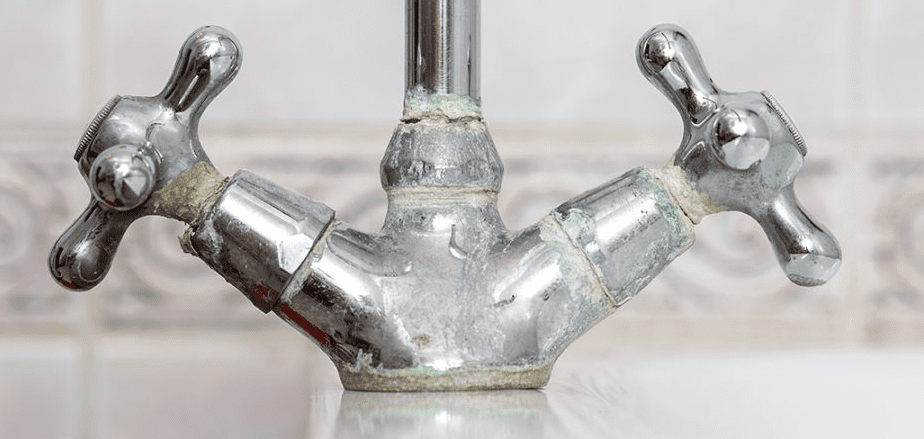
Why is it Essential to Remove limescale?
Limescale has a significant financial impact. If you have never lived without limescale in your appliances, you will find it difficult to believe. People who live in places with excessively hard water may attest to the rapid accumulation of mineral deposits on various kitchen equipment and utensils, especially those that heat water, such as coffee makers, dishwashers, washing machines, and kettles. Limescale accumulation can affect everything, including kitchen cookware.
Limescale reduces the durability and general effectiveness of appliances. Certain components will need to be repaired or replaced frequently. The accumulation of limescale, which can clog showerheads, is a typical problem. You may see a noticeable decrease in water pressure, which will be rather annoying.
Additionally, the obstruction created by limescale will increase utility costs. This is because for your appliances to function properly, they will require a greater amount of electricity and water. In addition to deteriorating tap seals, the scale will ultimately necessitate the services of a plumber. Scale can also lead to leakage.
In addition, limescale will decrease the value of your home because it degrades the beauty of your home’s fixtures. In severe circumstances, it could cause irreparable damage to chrome fittings. The rough substance will cause the chromium to fracture since it will be subjected to severe strain.
You should be aware that if limescale is not removed promptly, it will continue to accumulate and create sediment that is difficult to remove. If you fail to remove this buildup promptly, you should be aware of this.
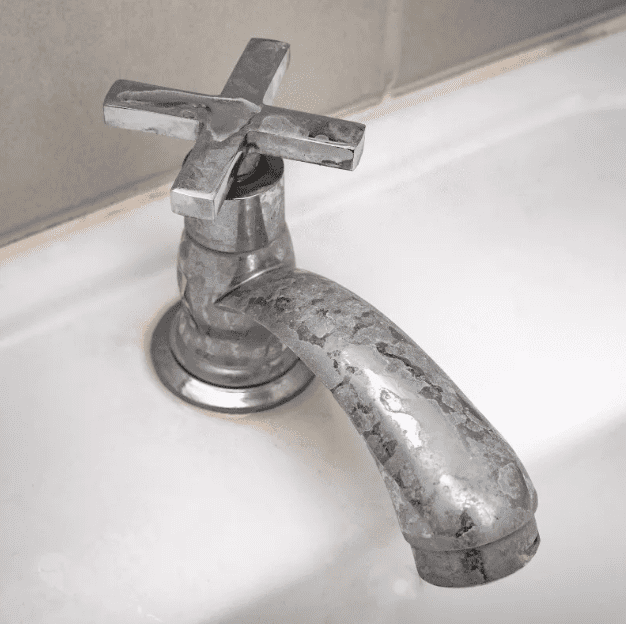
How to Remove Limescale Deposit
You can find a variety of online guides for removing limescale from your shower, along with other fixtures, faucets, and appliances. Contrary to appearances, some of the suggestions should be taken with a grain of salt because they are not as useful as they initially look.
Here Are Four Examples
1. Daily or do-it-yourself sanitizers for the home
Any liquid that is only slightly acidic should dissolve limescale. Typical acidic compounds found in our homes include vinegar and lemon juice, for instance. The cleaning solution created by combining bicarbonate of soda and vinegar is suitable for use on appliances and fixtures.
Fill a spray bottle with a solution composed of equal parts water and vinegar. The bathroom will be pristine after applying this cleaning solution. Showers, bathtubs, basins, and faucets should be sprayed with them to avoid the buildup of limescale. After washing the surfaces, be sure to thoroughly rinse them with clean water.
If you do not regularly clean your shower head and faucets, limescale will accumulate and become tough to remove. In this instance, a mixture of lemon juice and white vinegar will not be effective as a cleaning agent. It is especially helpful to soak a clogged shower head in vinegar overnight to unblock it.
For the mild acid to be effective, the buildup of shale on the surfaces your cleaning must be thin and not that hard to scrub off or you might be better off using another method.

2. Ion exchange-based technology
This approach is more in the line of prevention of shale buildup, however, it’s been proven over time soft water will eat away at the lime buildup in your pipes and clean them out for you. In a typical water softener, negatively charged resin beads attract positively charged hardness minerals in the water. This is because like charges repel while opposing charges attract.
During the ion exchange process, the hardness-causing minerals in the water are exchanged for minerals containing sodium or potassium. Due to their ionic characteristics, which imply that they have an electric charge, the minerals engage in this exchange. Once the water softener has filled up with hardness minerals it will regenerate itself to renew the resin beads and be ready to go again.

3. Reverse Osmosis
Organic waste, heavy metals, chlorine, hardness minerals, and other contaminants are filtered out of the water using a semi-permeable membrane with very small holes. This membrane is utilized to remove contaminants from water.
The water produced by a RO system is fully pure, risk-free, and unadulterated. You are free to ingest it, use it as a cooking component, and even pour it into your kettle, knowing that doing so will benefit your body and your gadgets.
It is imperative to remember that RO systems can only remove a limited amount of hardness from the water they treat. If your RO system is subjected to exceptionally hard water or water with a high mineral concentration, it will quickly clog. As a result, the membranes will need to be replaced more frequently. A water softener should be used in conjunction with a RO system.
The other factor when considering a whole house reverse osmosis is the cost, which is considerable and it is far more reasonable to be used in conjunction with a water softener.

4. What’s a Permanent solution?
To begin with, we feel it is necessary to warn you about purchasing any social media-advertised alternatives. If you choose to utilize them, you may be wasting your money because the majority of them are futile. This is illustrated by the avocation of magnetic or ionization inhibitors.
Laboratory testing however has demonstrated that this is not the case. Despite claims by the device’s producers that magnetic force is what softens the water, the evidence does not support this claim.
In this case, profit is the only thing that the manufacturer is concerned about. Consider the case below: One positive and nine negative testimonials have been received for a product that has sold one thousand units. To maintain a profit on the hundreds of sold devices, they will only reimburse nine clients.
The most efficient and long-lasting method for preventing limescale buildup is to soften the water before it enters the home. With the installation of a whole-house water softener, which filters hard water before it enters your plumbing, shale buildup can be avoided from entering your home in a simple and sustainable method.
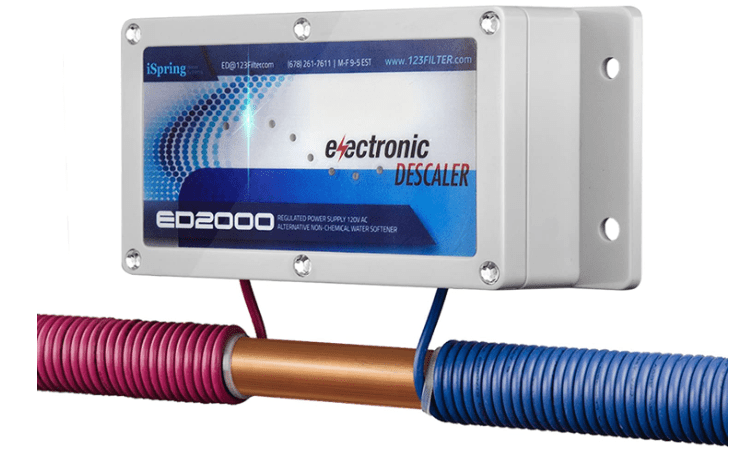
Benefits of Using a Water Softener
- It is beneficial in terms of cost reductions.
- You will discover that you use less water and soap when you clean, resulting in a decrease in your expenses.
- It extends the life of home appliances.
- Your water-using equipment will last longer without limescale buildup.
- Your skin will feel elastic and your hair will be silky.
- It protects against dryness without clogging pores.
- There will be a noticeable improvement in the softness and brightness of your laundry.
- You’ll spend less time cleaning, and you won’t have to be concerned about those annoying mineral stains.
- The cleanliness of your equipment, especially porcelain and glassware, will be enhanced.
- The usage of soft water can also assist in the removal of limescale that has accumulated in your plumbing system over time.
How to Descale a Kettle
Limescale accumulation in Canadian homes is a regular issue. Almost every device that utilizes water is affected by the issue. Particularly kettles can become clogged with chalky scales, necessitating frequent cleaning if you do not want the deposits to be in the next cup of tea that you prepare.
Limescale not only makes drinking coffee or tea less pleasurable, but it also reduces the longevity of your kettle over time. Therefore, we recommend that you educate yourself on how to descale your kettle. Two of the topics covered in this article are the elimination of limescale from kettles and the prolonging of their usable life.
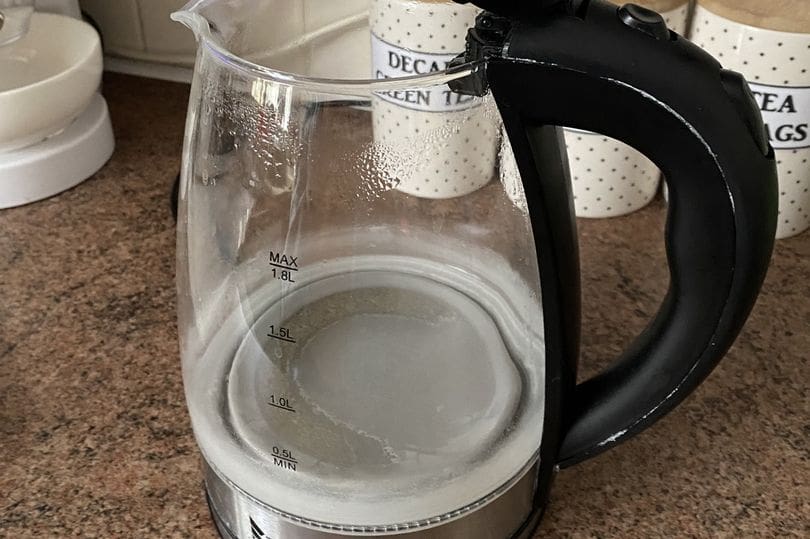
How does a Tea Kettle get Limescale?
Calcium carbonate, often known as limescale, is responsible for the clogging of the filaments in your kettle. These deposits are produced by the evaporation of water. In locations with hard water, this is a prevalent problem.
As we have mentioned earlier throughout its cycle water is capable of dissolving magnesium and calcium ions, resulting in hard water. There is hard water in both municipal water systems and private wells. The concentration of dissolved hard minerals is the key component that determines the hardness of the water. The limescale buildup in your kettle is the result of heat-induced mineral separation from the water.
Shale does not pose a serious threat to human health, but it can affect the taste of water and float to the surface. In addition, it causes the walls of your kettle to corrode with time.

How Often Should You Remove the Scale from Your Kettle?
If your water is exceptionally hard and you use your kettle frequently, you should descale it every month or every two months, depending on how often you use it. You must stop the scale from rising any further. The bigger the deposit, the greater the difficulty of its removal. To completely remove the thick deposits from the kettle, you will need to clean it not once, but twice.
If you reside in an area with hard water or use unfiltered water from a private well, you should descale your kettle at least once every month. If you reside in an area with soft water or possess a filter, you will need to descale less frequently, and in certain situations, you will not need to descale at all.
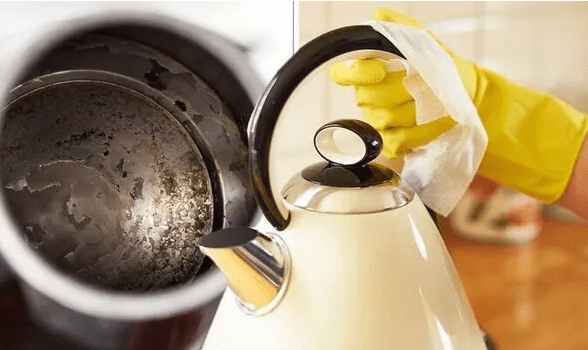
How To Specifically Descale a Kettle?
You are now aware of the origin of limescale and the mechanism by which it accumulates in your kettle. The next step is to educate yourself on how to go about descaling your kettle. The method is uncomplicated and can be executed with components normally accessible in a kitchen.
Lemon juice or white vinegar can be used to remove limescale and restore the kettle’s luster. This is because mild acids effectively remove thin layers of shale.
How to Use Vinegar to Descale Your Kettle
- To create a cleaning solution, combine equal amounts of water and vinegar in a container.
- Place your kettle on the heat and pour in the solution until it is approximately half-filled.
- After turning on the stovetop kettle, wait until the water boils before shutting it off.
- Allow the water to sit for thirty minutes.
- Empty the solution from the kettle, then fill it with clean water and give it a last rinse.
- Using a scrub brush with a long handle, you should remove any remaining flakes if necessary.
- Bring a half-full pot of fresh water to a boil, then add the remaining water. Remove the water, then continue the procedure. This will eradicate any remaining vinegar present.
Using Lemon Juice to Descale Your Kettle
The citric acid found in lemons is a powerful cleaning solution. If you have a kettle that has seen better days, we recommend using the formula described in the following text.
- Pour lemon juice into your kettle until it reaches the halfway mark. You should be able to find lemon juice at your local supermarket.
- Add ice to the tea pot’s water.
- Bring the solution to a boil, then remove it from the heat and allow it to sit for at least thirty minutes, or until the limescale has been eliminated.
- Pour off the liquid, and then scrub the pot well.
How to Use Soda to Clean Your Kettle
Given that the majority of carbonated beverages contain phosphoric acid and have a pH of roughly 2.8, they can be used as a cleaning agent in some situations. This is especially true for your different colas, such as Coke, Pepsi, and no-name brands as well.
- Before bringing your soda to a boil, place your kettle on the stove and fill it halfway with soda.
- Allow it to sit undisturbed for around forty-five minutes before dumping it out.
- Perform thorough cleaning on your tea kettle. Repeat if necessary.
How to Prevent Shale Buildup in the Kettle
One of the most essential measures you can take to minimize limescale formation is to empty your kettle after each use. If you want to maximize the amount of shale that accumulates, you should avoid letting the water sit until your next use. To avoid wasting water, only bring to a boil the amount of water you intend to use immediately.
How to Eliminate Limescale Deposition Forever
Hard water will have a detrimental impact on all of the water-using gadgets in your home. The minerals in hard water have long-term impacts and can cause a range of costly difficulties.
- It will leave scale deposits on your sinks, appliances, faucets, and shower screens.
- It will reduce the longevity of your appliances and lead them to fail.
- It will clog pipes, hence decreasing the available water pressure.
- It causes hair and skin to become itchy and dry, as well as dull and faded clothing.
How To Prevent the Accumulation of Limescale?
You must take preventative actions to eradicate limescale fully and permanently. It is highly recommended to get a water softener if you wish to eliminate the minerals that cause hardness. If you have a water softener that treats the entire home’s water supply, hard minerals will be eliminated from the water before it enters your residence.
In summary, since the introduction of kettles, limescale has been a source of irritation for many generations, and this will likely continue for a substantial period. It influences a range of household appliances, the kettle in particular.
Your health will not be compromised, but you will need to dispose of your kettle sooner than required. The kettle can be cleaned with vinegar, fruit juice, or baking soda. In addition, you can purchase a water softener system to eliminate the hard minerals in your water that lead to limescale production.

